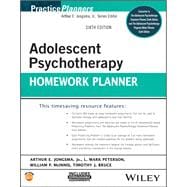Evidence-based and effective clinical homework for adolescent clients and their caregivers
In the newly updated sixth edition of The Adolescent Psychotherapy Homework Planner, a team of distinguished practitioners delivers a time-saving and hands-on practice tool designed to offer clients valuable homework assignments that will further their treatment goals for a wide variety of presenting problems. The Homework Planner addresses common and less-common disorders—including anxiety, depression, substance use, eating, and panic—allowing the client to work between sessions on issues that are the focus of therapy.
This book provides evidence-based homework assignments that track the psychotherapeutic interventions suggested by the fifth edition of The Adolescent Psychotherapy Treatment Planner. They are easily photocopied, and a digital version is provided online for the therapist who would prefer to access them with a word processor. The Homework Planner also offers:
- Cross-referenced lists of suggested presenting problems for which each assignment may be appropriate (beyond its primary designation)
- Several brand-new assignments, as well as adapted assignments that have been shortened or modified to make them more adolescent-client-friendly
- Homework assignments for the parents of adolescents in treatment, assignments for the adolescents themselves, and assignments for parents and adolescents to complete together
An essential and practical tool for therapists and practitioners treating adolescents, The Adolescent Psychotherapy Homework Planner, Sixth Edition will benefit social workers, psychologists, psychiatrists, and other clinicians seeking efficient and effective homework tools for their clients.









